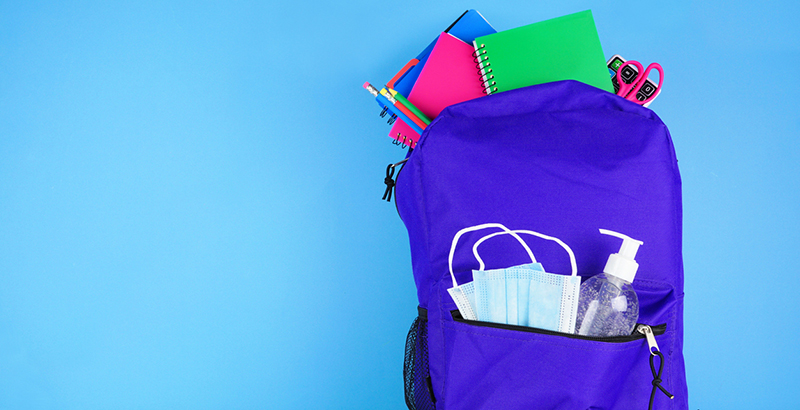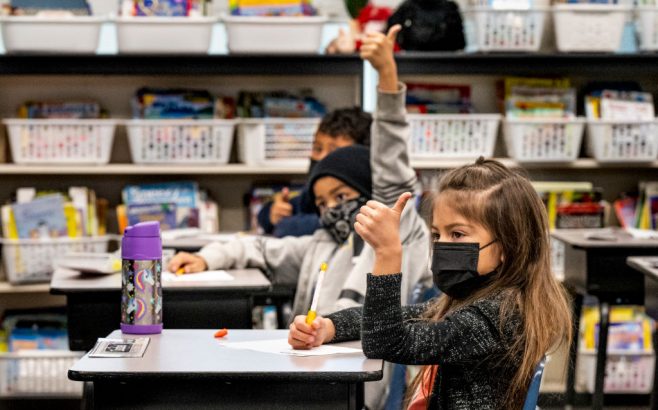The Week in COVID & Education Policy: New Study Finds School COVID Transmission Is Rare, Pfizer Applies for Approval for Young Kids’ Shot and More Key Updates

This is our weekly briefing on how the pandemic is shaping schools and education policy, vetted, as always, by AEI Visiting Fellow John Bailey. Click here to see the full archive. Get this weekly roundup, as well as rolling daily updates, delivered straight to your inbox — sign up for The 74 Newsletter.
With masks, transmission of COVID-19 in K-12 schools is low: New study published in Pediatrics
- Conclusion: “With universal masking, in-person education was associated with low rates of secondary transmission, even with less stringent distancing and bus practices. Given the rates of sports-associated secondary transmission, additional mitigation may be warranted.”
- “During the study period, 1,102,039 students and staff attended in-person instruction in 100 North Carolina school districts, 13 Wisconsin school districts and 14 North Carolina charter schools.”
- “Students and staff had 7,865 primary infections, 386 secondary infections and 48,313 quarantines.”
- “For every 20 community-acquired infections, there was 1 within-school transmission event.”
- “Relaxed distancing practices (less than 3 feet, 3 feet) and increased children per bus seat were not associated with increased relative risk of secondary transmission.”

February 4, 2022 — The Big Three
Pfizer applies for emergency use authorization for its vaccine for kids under 5: “Vaccines for children younger than 5 could be available far sooner than expected — perhaps by the end of February — under a plan that would lead to the potential authorization of a two-shot regimen in the coming weeks, people briefed on the situation” told the Washington Post.
- Pfizer statement on the “rolling submission”: “Ultimately, we believe that three doses of the vaccine will be needed for children 6 months through 4 years of age to achieve high levels of protection against current and potential future variants. If two doses are authorized, parents will have the opportunity to begin a COVID-19 vaccination series for their children while awaiting potential authorization of a third dose.”
- “In December, Pfizer said it was amending its clinical trial to test a three-dose version of the vaccine because the lower dose generated an immune response in 2- to 4-year-olds that was inferior to the response measured in 16- to 25-year-olds. In 6- month- to 24-month-old children, the vaccine generated an immune response in line with 16- to 25-year-olds.”
- “The FDA urged the companies to submit the application so that regulators could begin reviewing the two-shot data, according to the knowledgeable individuals, who spoke on the condition of anonymity because they were not authorized to speak publicly.”
- “People familiar with the updated two-dose data say the vaccine has a good safety profile in young children and showed an ability to prevent a significant number of COVID-19 cases.”
- “One person familiar with the most recent trial data, who spoke on condition of anonymity, said that those aged 2 to 4 years who were given shots were infected at a rate 57% lower than the children in the placebo group. Children aged 6 months to 2 years who got shots were infected at a rate 50% lower than the placebo group.”
- The FDA announced that the Vaccines and Related Biological Products Advisory Committee will meet Feb. 15 to discuss the Pfizer request. (Statement here)
- “It doesn’t make sense we would approve a two-dose vaccine on the assumption the third dose would make up for deficiencies of the two doses,” said Dr. Paul A. Offit, a panelist and director of the Vaccine Education Center at Children’s Hospital of Philadelphia. He also questioned why the company and FDA would still need to pursue a three-dose regimen if two doses are protective.”

New analysis of school closures: Emily Oster, Burbio and the COVID-19 School Data Hub are out with a new report.
- Data suggest school closures in January 2022 were more common in districts with less in-person school during 2020-21 and in districts with a larger share of students who were Black and Hispanic or eligible for free and reduced-price school lunch.
- “The data clearly indicate that school closures are disproportionately affecting districts that had less in-person learning and more virtual learning in the prior school year.”
American Academy of Pediatrics updates guidelines for schools: New guidelines and press release. Some of the highlights:
- “The American Academy of Pediatrics calls for renewed emphasis and support to keep schools open, stating in updated guidance that in-school learning should be prioritized, with diligent adherence to safety measures such as vaccination, universal masking and physical distancing.”
- Recommendations include universal masking indoors, vaccination for all who are eligible and modifying “mealtime school spaces to reduce the risk of spreading COVID-19, especially during periods of high transmission.”
- Related: CDC released updated guidance for child care programs last week.
Federal Updates
Education Department
- Secretary Miguel Cardona discusses his priorities (Press release / Text / Video).
- The department released the Notice of Proposed Priorities, definition and requirements for its Project Prevent discretionary grant program and launched the 30-day public comment period.
- The American Rescue Plan Partnership, Assistance, Transformation and Heightened Support (ARP PATHS) tool invites states to describe the strategies they are implementing that could serve as promising practices for other states and the nation in ensuring that funds are used appropriately and effectively, as intended by the law.
City & State News
Alabama: Schools lay out $2 billion federal COVID relief spending plans.
California: Sets a new bar for education and workforce data policy, says Data Quality Campaign.
Colorado:
- Launches new test-and-mask program to cut down on school quarantines.
- Cherry Creek School District, Adams 12 Five Star Schools, Denver and others dropping mask mandate beginning Monday.
Indiana: The Indiana Department of Education has launched a public database showing how much schools are spending in federal pandemic relief funding. News station WFYI also created a database of school district spending plans.
Louisiana: New Orleans is set to become the first district to mandate COVID-19 vaccinations for children 5 and up, though state regulations will allow parents to opt out easily.
New Jersey: To fill educator shortage, Camden will sponsor teachers from other countries. The substitute teacher shortage forced Millville Public Schools to give middle and high school students an entire month of half-days.
New York: NYC enrollment has shrunk to its lowest point in at least a decade — a drop of 10% since the pandemic started.
- “Black students saw the steepest declines since the 2019-20 school year, with a 14% decrease in enrollment. There was an 11% drop in the number of white students and a 9% decrease among Hispanic students.”
North Carolina: Educator builds mobile tutoring bus to reach students at home.
Virginia: Gov. Glenn Youngkin’s mask order prompts dueling lawsuits.
- “Parents of children with disabilities filed a federal lawsuit, arguing that forcing schools to repeal their mask mandates effectively excludes those students from public schools, in violation of the Americans With Disabilities Act.”
- “A separate suit was filed by three parents against the Loudoun County School Board for ignoring Younkin’s order and continuing the school district’s mask mandate.”
COVID-19 Research
Vaccinated parents give COVID protection to unvaccinated children: A new study out of Israel found that unvaccinated children may get indirect protection from COVID-19 through their vaccinated parents.
- “The study found that, regardless of household size, having one vaccinated parent decreased the risk of an unvaccinated child catching COVID by 23.4% on average.”
- “Two vaccinated parents decreased the risk by an average of 64.9%, although the risk only decreased by 58.1% during the delta wave compared to 71.7% during the alpha wave.”
- “Get everyone around them vaccinated, and that will protect your kid pretty well,” said [Dr. Amy] Edwards, who is the associate medical director, pediatric infection control at UH Rainbow Babies and Children’s Hospital in Cleveland. “It’s not complete protection, but it is better protection.”
- More via CIDRAP, which also covers a second study suggesting the same.
Kids wearing masks reduces child care center closures: New study from Yale and article in The 74.
- “In this survey study of 6,654 child care professionals from all 50 states, child masking at baseline (May 22 to June 8, 2020) was associated with a 13% reduction in program closure within the following year, and continued child masking throughout the one-year study period was associated with a 14% reduction in program closure.”
- “These results suggest that masking of children in child care programs is associated with reduced program closures, supporting current masking recommendation in younger children provided by the Centers for Disease Control and Prevention.”
- “Concerns have been raised regarding the potential for social and developmental delays when younger children wear a face mask for prolonged periods because of lack of recognition of emotional cues. Notably, these are point-in-time studies, and how quickly children adapt and recognize other emotional cues, such as body language, is not known. Evidence suggests that school-age children can identify most emotions in masked faces.Two-year-old children recognize spoken words better through an opaque mask compared with a clear face shield, suggesting verbal communication to infants is not harmed by face masks.”
Novavax applies to the FDA for emergency use authorization of COVID vaccine.
- “Novavax’s vaccine uses a more conventional approach than the vaccines that were more swiftly developed and authorized. That could make it appealing to people who are hesitant to be inoculated with vaccines like those from Pfizer-BioNTech and Moderna that use the newer messenger RNA technology. Novavax’s product uses tiny particles studded with viral proteins, mixed with an immune-boosting compound known as an adjuvant. The vaccine is given as two shots, spaced three weeks apart.”
Moderna received full FDA approval for its COVID vaccine (Moderna press release / FDA statement).
- Moderna continues to trail Pfizer in authorizations for teens and children; its vaccine has still not been green-lit for use in anyone under the age of 18 in the U.S.
Children and COVID-19: American Academy of Pediatrics’ State-Level Data Report
- “For the week ending Jan. 27, over 808,000 additional child COVID-19 cases were reported, down from the peak level of 1,150,000 reported the week ending Jan. 20.”
- “However, child cases this week remained extremely high, triple the peak level of the Delta surge in 2021.”
I Had COVID. Am I Done Now?: Asks Emily Oster in a good piece.
Omicron Has States Rethinking Broken School COVID Testing: Via Politico
Viewpoints
More than one-third of parents say their child was in quarantine in January: Via Morning Consult and EdChoice
- “In November and December, about a quarter of parents said they had a child who had to quarantine. But in January that number jumped to 37%.”
- “In January, three out of five school parents supported moving back to remote learning due to the Omicron variant. Democrats, Blacks, urbanities and younger generations were the most supportive of shifting to remote learning. Republicans and those living in small town/rural areas were least supportive.”
Online tutoring by college volunteers: Experimental evidence from a pilot program: Study and EdWeek article
- “College students from highly selective universities served as volunteer tutors working 1-on-1 with predominantly low-income students of color twice a week for 30 minutes during the school day. Tutoring focused on building personal relationships with students and supplementing their learning in math and reading.”
- “We find that the pilot program produced consistently positive but statistically insignificant effects on student achievement.”
- “At the same time, the online volunteer tutoring program we study is extremely low cost, making it far more cost-effective than other models. We spent $7,200 on [research assistant] staff to help coordinate tutoring, and $50 for a single Zoom account in which [the assistants] paired students and tutors in breakout sessions. CovEd operates with a thin budget, spending about $1,200 on their website and recruitment during the spring of 2021. Together, this amounts to a per-treated student cost of roughly $32.”
- More from The 74
America’s kids get an internet librarian: Via Axios: NewsGuard, a service that uses trained journalists to rate news and information sites, will become available to millions of public school students this week through a partnership with the American Federation of Teachers.
The Pandemic and College Student Engagement: Trends, Disparities and Opportunities: 2021 National Survey of Student Engagement.
COVID-Aid Spending Trends by City, Suburban, Rural School Districts: Via FutureEd.
Homeschooling Skyrocketed During the Pandemic, but What Does the Future Hold?: Via Daniel Hamlin and Paul Peterson at Education Next
Driving Towards Equity: Education Reform Now analysis of all 50 state ESSER plans.
The story behind Black History Month: And why it’s celebrated in February.
…And on a Lighter Note
An 8-Year-Old Wrote a Book and Hid It on a Library Shelf. It’s a Hit: Via NYT, Washington Post and KTVB
- “Dillon Helbig, a second-grader from Idaho, wrote an 81-page book about his ‘Crismis’ adventures.”
- “When his grandmother took him to the Lake Hazel branch of the Ada Community Library in Boise at the end of December, he slipped the sole copy of his book onto a shelf containing fiction titles.”
- “The book, ‘The Adventures of Dillon Helbig’s Crismis’ by the author ‘Dillon His Self,’ had drawn so much attention by the end of January that 56 people were on the waiting list to check it out, said Alex Hartman, the manager of the library branch.”
- “The night after Dillon surreptitiously left his book on that library shelf, he came clean to his parents, his mother, Susan Helbig, said. They called the library, thinking they could pick it up from the lost and found. But the librarians were so charmed by the book that they played along with Dillon’s stunt.”
- “The librarians entered the book in their catalog system, but left the publisher category blank… They also moved it out of the fiction section and set it alongside the graphic novels, since it has so many page-length illustrations.”
- Video segment here
Peyton Manning: On watching the NFL playoff games ‘Emily in Paris’.
Peyton Manning absolutely killed it on SNL, funniest segment I’ve seen on SNL in years. pic.twitter.com/Ze0mnVYRyw
— Clay Travis (@ClayTravis) January 30, 2022
ICYMI @The74
Weekend Reads: In case you missed them, our top five stories of the week:
-
- Research: Increasing segregation of Latino students hinders academic performance and could amplify COVID learning loss
- New York City: The surprising numbers behind which schools actually educate students
- Tutoring: As schools push for more tutoring, new research points to its effectiveness — and the challenge of scaling it to combat learning loss
- Commentary: The banning of ‘Maus’ is only the latest echo from the rise of the Nazis. We cannot claim to not see the warnings
- 74 Interview: CASEL’s ‘consensus builder’ CEO Aaliyah Samuel on getting the U.S. ‘back to the middle’ on social-emotional learning — and whether the name needs to change
For even more COVID policy and education news, subscribe to John Bailey’s daily briefing via Substack.
Disclosure: John Bailey is an adviser to the Walton Family Foundation, which provides financial support to The 74.
Get stories like these delivered straight to your inbox. Sign up for The 74 Newsletter

;)
